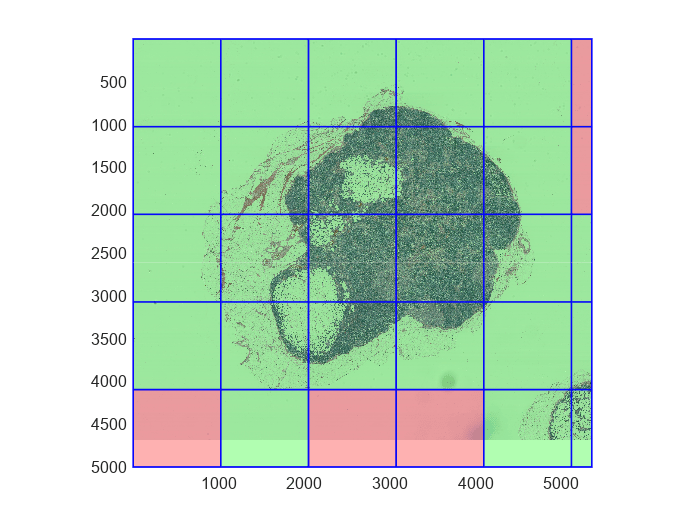bigimage
(To be removed) Out-of-core processing of very large images
The bigimage object will be removed in a future release. Use the
blockedImage object
instead. For more information, see Version History.
Description
A bigimage object stores information about a large TIFF image
file and the image data it contains. A bigimage represents images as
smaller blocks of data that can be independently loaded and processed.
Use a bigimage object to visualize and process images that are too
large to fit in memory, or when processing the image requires more memory than is available.
Additionally, the object can:
Read, process, and display images at different multiple resolution levels (image pyramids).
Read arbitrary regions of the image.
Read, set, and write blocks of data.
For big images with multiple resolution levels, the lowest or coarsest resolution level is the level where each pixel covers the largest area. The highest or finest resolution level is the level where each pixel covers the smallest area.
Creation
Syntax
Description
bigimg = bigimage( creates a
filename)bigimage object from the big image file with name
filename.
bigimg = bigimage( creates a
dirname)bigimage object from a directory with name
dirname containing files with big image data.
bigimg = bigimage( creates a
varname)bigimage object from the variable varname in the
workspace.
bigimg = bigimage(spatialReferencing,channels,classUnderlying)
creates a writable bigimage object and sets the SpatialReferencing,
Channels, and ClassUnderlying properties,
without initializing the image data.
bigimg = bigimage(levelSizes,channels,classUnderlying) creates a
writable bigimage object and sets the LevelSizes, Channels, and ClassUnderlying properties,
without initializing the image data.
bigimg = bigimage(___,'Classes',classes,'PixelLabelIDs',pixelLabelIDs)
creates a bigimage object with categorical data. Specify class names
using the Classes property and the
mapping of image pixel label values to categorical class names using the PixelLabelIDs
property.
bigimg = bigimage(___,Name,Value) uses name-value
pairs to set one or more of the BlockSize, SpatialReferencing, UndefinedID, UnloadedValue properties. You can
specify multiple name-value pairs. Enclose each property name in quotes.
For example, bigimage(bigfile,'BlockSize',[256
256],'UnloadedValue',128) creates a big image from file
bigfile that has a block size of 256-by-256 pixels and a default
pixel value of 128.
Input Arguments
Properties
Object Functions
apply | (To be removed) Process blocks of bigimage object |
isequal | (To be removed) Compare two bigimage objects for
equality |
getBlock | (To be removed) Read block of bigimage object |
getFullLevel | (To be removed) Get all data in one level of bigimage
object |
getRegion | (To be removed) Read arbitrary region of bigimage
object |
setBlock | (To be removed) Put data in specific block of bigimage
object |
write | (To be removed) Write bigimage object content to new
file |
Examples
Tips
You can write to
bigimageobjects that are created using theSpatialReferencingorLevelSizessyntaxes. Write to thesebigimageobjects by using thesetBlockfunction. You cannot write tobigimageobjects that are created using thefilename,dirname, orvarnamesyntaxes.A
bigimageobject uses the UnloadedValue property in two situations. The first situation is when you create a writablebigimageobject. Blocks of the writablebigimageobject are set toUnloadedValueuntil you write the block data by using thesetBlockfunction. The second situation is when theapplyfunction stops processing blocks of abigimageobject before all blocks are processed.
References
[1]
[2]


